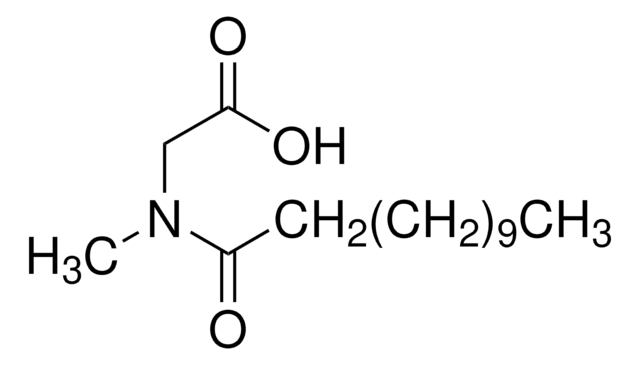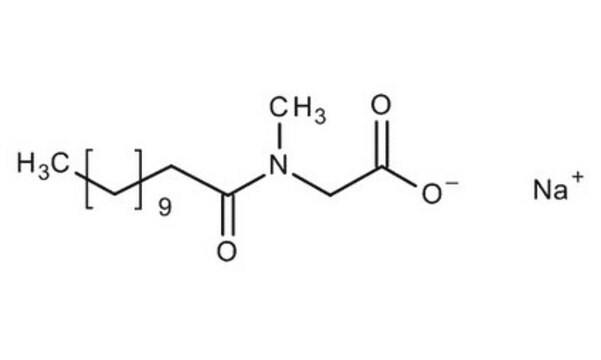61743
N-Lauroilsarcosina sodium salt
BioUltra, for molecular biology, ≥99.0% (HPLC)
Sinónimos:
N-Dodecanoil-N-metilglicina sodium salt, Sarkosyl NL
About This Item
Productos recomendados
grade
for molecular biology
Quality Level
description
anionic
product line
BioUltra
assay
≥99.0% (HPLC)
form
powder
mol wt
micellar avg mol wt 600
average mol wt 600
aggregation number
2
impurities
DNases, none detected
RNases, none detected
insoluble matter, passes filter test
phosphatases, none detected
proteases, none detected
loss
≤1% loss on drying, 110 °C
pH
7.0-9.0 (25 °C, 1 M in H2O)
CMC
14.6 mM (20-25°C)
solubility
H2O: 1 M at 20 °C, clear, colorless
anion traces
chloride (Cl-): ≤50 mg/kg
sulfate (SO42-): ≤50 mg/kg
cation traces
Al: ≤5 mg/kg
As: ≤0.1 mg/kg
Ba: ≤5 mg/kg
Bi: ≤5 mg/kg
Ca: ≤10 mg/kg
Cd: ≤5 mg/kg
Co: ≤5 mg/kg
Cr: ≤5 mg/kg
Cu: ≤5 mg/kg
Fe: ≤5 mg/kg
K: ≤50 mg/kg
Li: ≤5 mg/kg
Mg: ≤5 mg/kg
Mn: ≤5 mg/kg
Mo: ≤5 mg/kg
Ni: ≤5 mg/kg
Pb: ≤5 mg/kg
Sr: ≤5 mg/kg
Zn: ≤5 mg/kg
λ
1 M in H2O
UV absorption
λ: 260 nm Amax: 0.2
λ: 280 nm Amax: 0.06
SMILES string
[Na+].CCCCCCCCCCCC(=O)N(C)CC([O-])=O
application(s)
sample preservation
InChI
1S/C15H29NO3.Na/c1-3-4-5-6-7-8-9-10-11-12-14(17)16(2)13-15(18)19;/h3-13H2,1-2H3,(H,18,19);/q;+1/p-1
InChI key
KSAVQLQVUXSOCR-UHFFFAOYSA-M
¿Está buscando productos similares? Visita Guía de comparación de productos
General description
Application
- of nuclease stop mix, embryo extract buffer to dissociate nonspecifically bound proteins from chromatin
- of proteinase K solution for the heat denaturation of genomic DNA
- of 10% (w/v) sarcosyl/0.5 M ethylenediaminetetraacetic acid (EDTA) solution to prepare EDTA-sarcosyl-proteinase (ESP) buffer
- in the hybridization buffer for in situ hybridization histochemistry
- in the embryo extract buffer to dissociate nonspecifically bound proteins from chromatin
- in proteinase K solution to inactivate the enzymes
Other Notes
signalword
Danger
hcodes
Hazard Classifications
Acute Tox. 2 Inhalation - Eye Dam. 1 - Skin Irrit. 2
Storage Class
6.1A - Combustible acute toxic Cat. 1 and 2 / very toxic hazardous materials
wgk_germany
WGK 1
flash_point_f
512.6 °F - closed cup
flash_point_c
267 °C - closed cup
ppe
Eyeshields, Gloves, type N95 (US)
Elija entre una de las versiones más recientes:
¿Ya tiene este producto?
Encuentre la documentación para los productos que ha comprado recientemente en la Biblioteca de documentos.
Los clientes también vieron
Nuestro equipo de científicos tiene experiencia en todas las áreas de investigación: Ciencias de la vida, Ciencia de los materiales, Síntesis química, Cromatografía, Analítica y muchas otras.
Póngase en contacto con el Servicio técnico









